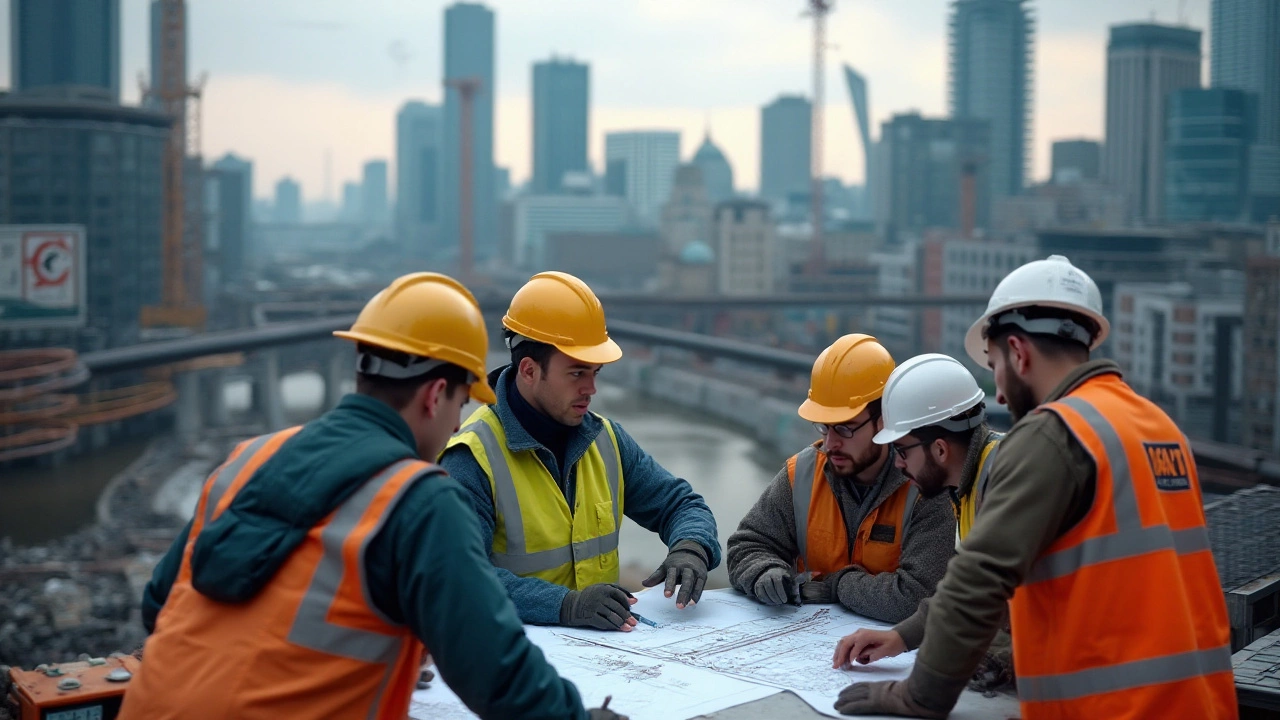Civil construction is a term that refers to the creation of infrastructure involving anything from roads and railways to skyscrapers and bridges. It forms the backbone of modern urban landscapes and is key to connecting communities and enhancing the quality of life.
The process demands meticulous planning and coordination, involving various stages from conceptualization to execution. Professionals in the field work together to ensure that the infrastructure is safe, sustainable, and efficient.
Throughout this article, we will explore the diverse components and tasks that fall under civil construction. We will look at the significance of roles played by engineers and contractors, the materials that are commonly used, and the latest trends influencing construction today.
- Core Projects in Civil Construction
- The Role of Civil Engineers and Contractors
- Materials and Methods Used
- Emerging Trends in Civil Construction
Core Projects in Civil Construction
When we talk about civil construction, we're dealing with a wide array of projects that shape our communities and connect us. These projects are the bedrock of infrastructure development and can range significantly in scale and complexity. Roadways are a prime example; they weave intricate networks that facilitate transportation and trade, playing a crucial role in economic development. Constructing these arteries involves meticulous planning, from surveying and excavation to paving and maintenance, each step demanding precision and care. Airports represent another significant category of civil projects. More than just runways, airports demand a wealth of infrastructure such as terminals, access roads, and cargo facilities. They require coordination among various disciplines—architecture, engineering, paving, and technology—to ensure efficient operation and safety. Such projects not only involve constructing the visible elements but also entail great emphasis on underground utilities, lighting systems, and environmental management.
Bridges, yet another core aspect of civil construction, symbolize human ingenuity. They span rivers, valleys, and urban landscapes, allowing seamless movement and connectivity, essential for trade, travel, and communication. Designing bridges involves advanced structural analysis to determine load distributions while considering aesthetic appeal and local climate conditions. The materials used, such as steel and concrete, are carefully selected for their resilience and durability. Dams and water supply projects are also fundamental to civil construction. They manage water resources for consumption, irrigation, and hydroelectric power. Constructing a dam is a massive undertaking involving earthworks, hydraulic systems, and complex safety precautions. These structures need constant supervision and improvement to meet modern environmental and safety standards.
"Civil engineering is not only the heart of infrastructure but the epitome of sustainable development," notes renowned civil engineer, John A. Hudson. "Its projects bear the responsibility of conserving resources while catering to the needs of future generations, demanding a balance of innovation and practicality."
Finally, urban development projects such as residential complexes and commercial buildings are part of the civil construction sphere. These ventures require a fusion of structural engineering, architecture, and urban planning. From foundation to finishing touches, every aspect must comply with stringent regulations and standards to ensure safety and functionality. In recent years, there has been a marked shift towards incorporating smart technologies in these buildings for energy efficiency and user comfort. Understanding each type of core project within the realm of civil construction is essential for appreciating the impact these structures have on everyday life. They are results of comprehensive design strategies and innovative solutions aimed at bettering our living environments.

The Role of Civil Engineers and Contractors
Civil engineers and contractors play pivotal roles in the world of civil construction. Their expertise and collaboration set the foundation, quite literally, for the successful execution of commercial and infrastructural projects. Civil engineers are typically responsible for the design, construction, and maintenance of the physical and naturally built environment. This could be anything from large buildings and bridges to smaller structural elements like culverts and retaining walls. Their work begins at the conceptual stage and continues through the lifecycle of the project. They ensure safety and compliance with various regulations, making use of mathematics and science to solve real-world problems.
Contractors, on the other hand, bring these plans to life. Acting as the liaison between the design plans provided by engineers and the physical reality of the construction site, contractors oversee the day-to-day operations. They are tasked with ensuring that construction projects are completed on time, within budget, and to the required quality standards. This means coordinating labor, procuring materials, and managing logistics. Additionally, contractors must possess a deep understanding of construction law and ethics, as these are critical components of all construction-related ventures. Together, civil engineers and contractors weave the threads of creativity and practicality to transform blueprints into tangible structures.
Responsibilities of Civil Engineers
One of the key roles of civil engineers in commercial construction is conducting feasibility analyses before any ground is broken. This involves assessing the viability of proposed projects, taking into account factors like cost, environmental impact, legal implications, and budget constraints. Through site surveys and investigations, they gather essential data that informs project design and helps mitigate potential risks. Another crucial aspect is the development of detailed project plans and specifications. This lays out everything from structural designs to material requirements and construction timelines, providing a clear roadmap for contractors to follow. Engineers also use software and simulation tools to model structures and predict performance under various scenarios, ensuring resilience and sustainability.
Contractors' Critical Duties
The role of contractors is as diverse as it is vital. The primary responsibility of contractors is project management. This means everything from scheduling and resource allocation to direct project oversight on the ground. They are the linchpin of communication between various stakeholders, from clients and engineers to on-site laborers and municipal authorities. Quality control and assurance are another fundamental contractor responsibility. This entails regular inspections to ensure construction meets the set standards and adheres to the designs laid out by engineers. Contractors often employ sophisticated project management and reporting software to track progress in real-time, addressing any issues that arise promptly. In a rapidly evolving sector, they must stay updated on the latest construction trends and technologies to enhance efficiency and safety.
"The best civil engineers and contractors are those who can blend creativity with practicality, technical expertise with on-the-ground experience." - Anonymous Industry Expert

Materials and Methods Used
When it comes to civil construction, the selection of materials and the methods employed can significantly influence the outcome of a project. This section explores some of the most critical resources and techniques that are fundamental to the field. Traditionally, materials like concrete, steel, and wood have been cornerstones, each chosen for its strength, durability, and performance under various conditions. Its unmatched compressive strength makes concrete a favorite for the foundation and skeletons of many structures. Steel is often used in combination with concrete to create reinforcements, thanks to its tensile strength. Wood, although less conventional in massive structures, has seen a renaissance with advances in engineering and sustainability practices.
The methodologies in construction also play a pivotal role. Modern approaches such as prefabrication and modular construction are gaining traction for their efficiency and cost-effectiveness. These methods involve assembling components of a structure at a manufacturing site and transporting them to the intended location. Not only does this reduce construction time, but it also minimizes on-site disruptions. A revolutionary technique, Building Information Modeling (BIM), assists architects and engineers in crafting detailed digital representations of a building’s physical and functional properties. According to the National Institute of Standards and Technology, "BIM can save up to 20% of a project's construction costs."
Another crucial aspect is sustainability, which is becoming a primary focus in current construction projects. The industry is gradually shifting towards using eco-friendly materials such as bamboo and recycled metals. These are not only sustainable but also reduce the carbon footprint of the building process. In many cases, they're combined with traditional technologies for innovative results. In addition, methods like rainwater harvesting and solar panel installations are being integrated to make buildings more environmentally friendly and less reliant on nonrenewable resources.
With technological advancements, options like 3D printing are beginning to influence construction methods, promising to revolutionize how we approach building. This method allows for the creation of complex geometries that traditional methods might find challenging. Interestingly, it also reduces waste by precisely controlling the distribution of materials. A report from McKinsey & Company has found that 3D printing has the potential to cut construction time by 80%. This advancement signifies a leap towards a future where construction is faster, more economical, and highly efficient, supporting the demands for rapid urbanization.
While the materials and methods used in commercial construction today are extensive and varied, the implications of choosing the right ones are universal. They affect cost, safety, efficiency, and environmental impact, among many other aspects. As innovation becomes more integrated into civil engineering practices, the industry is bound to see even more significant, fascinating shifts in how infrastructure is conceived and created. These developments reflect a dynamic field constantly evolving, influenced by economic needs, technological capabilities, and environmental responsibilities.

Emerging Trends in Civil Construction
In today's ever-evolving construction landscape, new trends are continually shaping the way civil construction projects are planned and executed. A critical trend that has gained traction in recent years is the use of sustainable practices and green building techniques. With increasing awareness of environmental impact, companies are prioritizing the use of eco-friendly materials and energy-efficient systems, which not only reduce carbon footprints but also cut down on operating costs in the long run. Incorporating solar panels, smart technologies, and reusable materials is becoming more commonplace, reflecting a shift towards sustainable development in the industry.
Technology plays another pivotal role in transforming the commercial construction sector. The implementation of Building Information Modeling (BIM) allows for more precise planning and simulation of projects before they break ground. This innovative technology helps engineers and architects visualize the structural components and systems in an integrated manner. With BIM, potential challenges can be identified and solved during the design phase, significantly reducing time and cost overruns. A report by McKinsey Global Institute suggests that projects utilizing BIM can enhance productivity by 20-30%, showing its remarkable impact. As technological advancements continue, tools such as drones and 3D printing are also finding their place in construction, enabling faster and safer project completion.
According to The Royal Institution of Chartered Surveyors, "The integration of digital technologies in construction reduces error margins and streamlines communication, leading to more coherent project management."The rising trend of modular construction is redefining how structures are built. Prefabrication and modular solutions allow for quick assembly of building components manufactured off-site in controlled environments. This method minimizes the risks associated with onsite work, like weather-related delays, bringing more predictability to project timelines. As commercial projects demand tighter schedules, the ability to complete much of the construction off-site and rapidly assemble it on-site represents a significant breakthrough. This trend aligns with the need for efficient, scalable building solutions, especially in rapidly growing urban areas where time is of the essence.
Finally, there is a growing emphasis on advanced project management software that enhances collaboration among project stakeholders. These tools facilitate real-time communication, ensuring that everyone from architects to contractors is on the same page throughout the project lifecycle. Such software can integrate multiple modules covering everything from resource allocation to budgeting and risk management, making it easier to track progress and adapt to changes swiftly. It is clear that as these trends become more pronounced, the blending of innovation and efficiency in infrastructure development is poised to redefine the future of civil construction.





